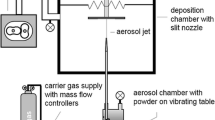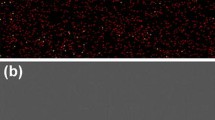Abstract
Alumina is the great potential material for the high-energy-storage application. Annealing temperature, ambient humidity and temperature are crucial parameters for further investigations of alumina dielectrics. Highly dense and uniform amorphous alumina thin films were prepared by sol–gel and spin-coating technology. The effects of annealing temperature, relative ambient humidity and temperature on dielectric properties of amorphous alumina thin films were first investigated. The annealing temperature varied from 450 to 700 °C. The ambient humidities of 20, 40, 60 and 80% were chosen. The leakage current density of film annealed at 450 °C showed strong dependence on the ambient humidity. However, the effect of ambient humidity on leakage current density weakened as the annealing temperature rising. At the constant ambient humidity, films annealed at 450 and 500 °C showed lower leakage current densities than films annealed at 600 and 700 °C. The various annealing temperatures made little influence on dielectric loss but can enhance slightly the dielectric constant at 500 °C. The annealing temperature of 500 °C was reasonable and the resulting films exhibited stable conduction mechanism at various ambient temperatures. Moreover, the annealing temperature, ambient humidity and temperature did not make the remarkable influence on the breakdown strength.








Similar content being viewed by others
References
X. Nie, E.I. Meletis, J.C. Jiang, A. Leyland, A.L. Yerokhin, A. Matthews, Abrasive wear/corrosion properties and TEM analysis of Al2O3 coatings fabricated using plasma electrolysis. Surf. Coat. Technol. 149, 245–251 (2002)
A.C.M. Esther, N. Sridhara, S.V. Sebastian et al., Optical and RF transparent protective alumina thin films. J. Mater. Sci. 26, 9707–9716 (2015)
G. Ortega-Cervantez, G. Rueda-Morales, J. Ortiz-Lopez, Cold-wall CVD carbon nanotube synthesis on porous alumina substrates. J. Mater. Sci. 20, 403–407 (2009)
C.L. Huang, J.J. Wang, F.S. Yen, C.Y. Huang, Microwave dielectric properties and sintering behavior of nano-scaled (α+θ)-Al2O3 ceramics. Mater. Res. Bull. 43, 1463–1471 (2008)
B. Soltani, M. Babaeipour, A. Bahari, Studying electrical characteristics of Al2O3/PVP nano-hybrid composites as OFET gate dielectric. J. Mater. Sci. (2016). doi: 10.1007/s10854-016-6064-2
D.D. Marco, K. Drissi, N. Delhote, O. Tantot, P.M. Geffroy, S. Verdeyme, T. Chartier, Dielectric properties of pure alumina from 8 GHz to 73 GHz. J. Eur. Ceram. Soc. 36, 3355–3361 (2016)
N.H. Fletcher, A.D. Hilton, B.W. Ricketts, Optimization of energy storage density in ceramic capacitors. J. Phys. D 29, 253–258 (1996)
A. Boumaza, L. Favaro, J. Lédion, G. Sattonnay, J.B. Brubach, P. Berthet, A.M. Huntz, P. Roy, R. Tétot, Transition alumina phases induced by heat treatment of boehmite: an X-ray diffraction and infrared spectroscopy study. J. Solid. State. Chem. 182, 1171–1176 (2009)
Y.W. Li, Q. Qiao, Z. Dong, J.Z. Zhang, Z.G. Hu, J.H. Chu, Enhanced dielectric properties in bismuth-doped alumina films prepared by atomic layer deposition. J. Non-Crysta. Solid. 443, 17–22 (2016)
P.J. Kelly, R.D. Arnell, Control of the structure and properties of aluminum oxide coatings deposited by pulsed magnetron sputtering. J. Vac. Sci. Technol. A 17, 945–953 (1999)
M.S. Al-Robaee, G.N. Subbanna, K.N. Rao, S. Mohan, Studies of the optical and structural properties of ion-assisted deposited Al2O3 thin films. Vacuum 45, 97–102 (1994)
A.K. Dua, V.C. George, R.P. Agarwala, Characterization and microhardness measurement of electron-beam-evaporated alumina coatings. Thin Solid Films 165, 163–172 (1988)
J.B. Kim, D.R. Kwon, K. Chakrabarti, C. Lee, K.Y. Oh, J.H. Lee, Improvement in Al2O3 dielectric behavior by using ozone as an oxidant for the atomic layer deposition technique. J. Appl. Phys. 92, 6739–6742 (2002)
M.T. Aguilar-Gama, E. Ramírez-Morales, Z. Montiel-González, Structure and refractive index of thin alumina films grown by atomic layer deposition. J. Mater. Sci. 26, 5546–5552 (2015)
A.W. Ott, J.W. Klaus, J.M. Johnson, S.M. George, Al2O3 thin film growth on Si(100) using binary reaction sequence chemistry. Thin Solid Films 292, 135–144 (1997)
M. Yao, P. Zou, Z. Su, J.W. Chen, X. Yao, The influence of Yttrium on leakage current and dielectric properties of amorphous Al2O3 thin film derived from sol-gel. J. Mater. Sci. 27, 7788–7794 (2016)
M Yao, Z Su, P Zou, J.W. Chen, F Li, X. Yao, Dielectric properties under high electric field for silicon doped alumina thin film with glass-like structure derived from sol-gel process. J. Alloy. Compd. 690, 249–255 (2017)
A.A. Hind, V.H. Grassian, FT-IR study of water adsorption on aluminum oxide surfaces. Langmuir 19, 341–347 (2002)
L.A. Phillips, G.B. Raupp, Infrared spectroscopic investigation of gas-solid heterogeneous photocatalytic oxidation of trichloroethylene. J. Mol. Catal. 77, 297–311 (1992)
D.N. Goldstein, J.A. Mccormick, S.M. George, Al2O3 atomic layer deposition with trimethylaluminum and ozone studied by in situ transmission FT-IR spectroscopy and quadrupole mass spectrometry. J. Phys. Chem. C 112, 19530–19539 (2008)
S. Ahmad, A. Ibrahim, R. Alias, S.M. Shapee, Z. Ambak, S.Z. Zakaria, M.R. Yahya, Thermal and electrical characterization of alumina substrate for microelectronic applications. AIP Conf. Proc. 1217, 442–446 (2010)
H. Birey, Dielectric properties of aluminum oxide films. J. Appl. Phys. 45, 2898–2904 (1978)
A. Rose, Space-charge-limited currents in solids. Phys. Rev. 97, 1538–1544 (1955)
Y. Peng, M. Yao, R. Xiao, X. Yao, Electrical properties of sol-gel derived Mg-doped Al2O3 films. J. Mater. Sci. 27, 11495–11501 (2016)
S.K. Sahoo, R.P. Patel, C.A. Wolden, Leakage current mechanisms in high performance alumina-silicone nanolaminate dielectrics. Appl. Phys. Lett. 101(1–4), 142903 (2012)
Acknowledgements
This work is supported by the Ministry of Science and Technology of China through 973-project (Grant No. 2015CB654601) and National Science Foundation of China (Grant No. 51272177).
Author information
Authors and Affiliations
Corresponding author
Rights and permissions
About this article
Cite this article
Su, Z., Yao, M., Chen, J. et al. Effects of annealing temperature, ambient humidity and temperature on dielectric properties of sol–gel-derived amorphous alumina thin film. J Mater Sci: Mater Electron 28, 12356–12362 (2017). https://doi.org/10.1007/s10854-017-7055-7
Received:
Accepted:
Published:
Issue Date:
DOI: https://doi.org/10.1007/s10854-017-7055-7




